After work today, I got home and found Spring relaxing and reading a book. I had stopped by the grocery store on the way home from work and picked up some chocolate cheesecake ice-cream by Ben and Jerry's. After plonking some into a cone, Spring was a very happy customer.
Monty and I sat for a while in the backyard while I read my new Roger Phillips Mushrooms book - a comprehensive guide with over 1,2 50 detailed photographs of mushrooms and other fungi in it (that's what the cover says). I am freaking out excited happy happy happy with this book. My bushcraft knowledge is lacking in this area - I know Oyster, and Aminita Muscaria or Fly Agaric mushrooms, and maybe 4 other ones, but that's it.

Mushrooms: A Comprehensive Guide with Over 1,2500 Detailed Photograph
Then as the light began to fall, I grabbed the hound dog named Monty, put on his harness, clipped on his leash, left the house and began a walk into the back park.
I found three distinctly different mushrooms - and I didn't even wander into the valley to find these. All three of these mushrooms have gills (as opposed to pores)..
Once we got home, I put them all onto a tea towel and took a few pictures, the first of the whole lot:
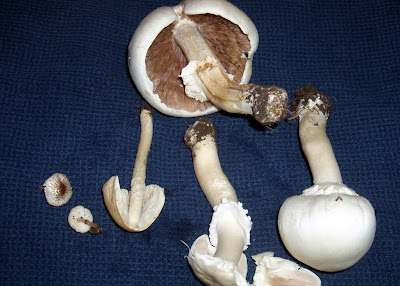
The first ones that I picked up were huge Field Mushrooms - Agaricus campestris L.
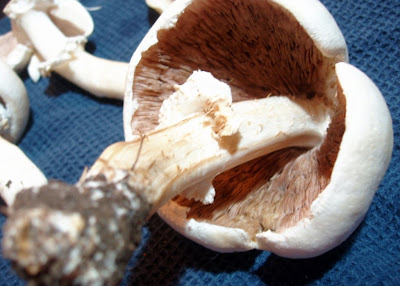
Habitat in pasture; late summer to autumn. Very common. Edible excellent. I carefully reviewed the book to make sure that these are what I had - without a doubt, they were Field Mushrooms.
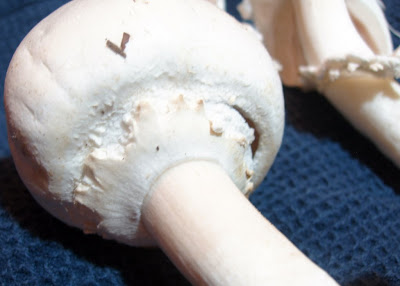
I saw them up at the top of a grassy field in the back park - bright and white against the green grass.
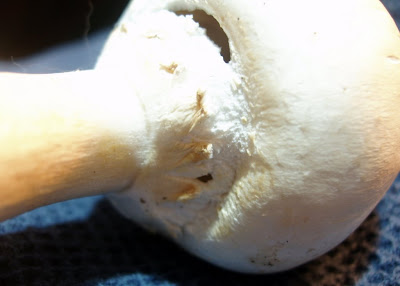
I didn't have a bag with me at the time, so I had to carry them all in my hands. They were large and heavy.
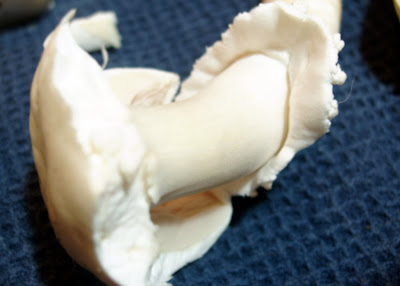
The family Agaricus' common name is the Wood Mushroom or simply Mushroom.
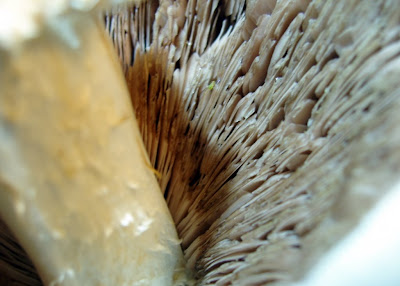
Tomorrow I will grab a few more, and slice them up and put them into a frying pan with butter, salt and pepper and put them on a french baguette for a nice evening meal.
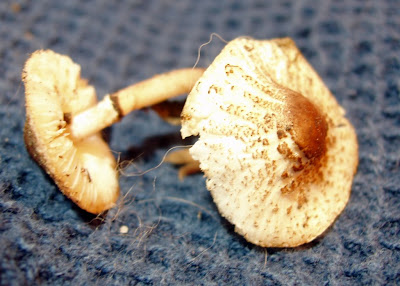
The next ones I found were considerably smaller - I actually found these in my backyard in a bare area of earth behind the house, where no other plants grow. This is Lepiota felina (Pers.). They are super small. Whereas the field mushrooms were large 4' wide in diameter and 5 1/2 ' high, the small ones were 4/7' wide and 1/2' high. What distinguishes these are the ring membranes around the shaft (that dark line on the left mushroom), the tufts of elongated hairs on the top (obvious in the photo), and finally the fact that the top of the mushroom is slightly umbonate. That means there is a little bulge or crown on the very top. That's the brown part. The book says that this one is not edible, possibly poisonous. So - no butter, salt and pepper for this one. Anyway, it's too darned tiny to eat.
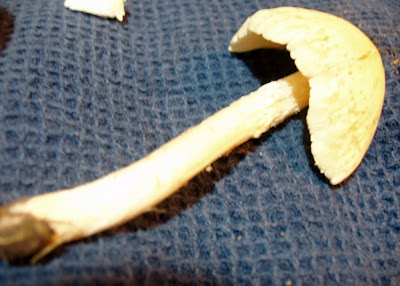
Finally, my backyard yielded some Common Inkcap Coprinus atramentarious (Bull.) The book says, as I have written before, that this Common Inkcap causes:
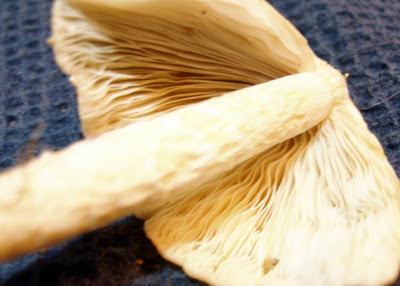
Well, that's all the mushroom exploration I have for tonight - and that was just a short walk in the back park. Can't wait to go into the valley again with my camera and to hunt for many more varieties.
Cheers,
Mungo
Monty and I sat for a while in the backyard while I read my new Roger Phillips Mushrooms book - a comprehensive guide with over 1,2 50 detailed photographs of mushrooms and other fungi in it (that's what the cover says). I am freaking out excited happy happy happy with this book. My bushcraft knowledge is lacking in this area - I know Oyster, and Aminita Muscaria or Fly Agaric mushrooms, and maybe 4 other ones, but that's it.

Mushrooms: A Comprehensive Guide with Over 1,2500 Detailed Photograph
Then as the light began to fall, I grabbed the hound dog named Monty, put on his harness, clipped on his leash, left the house and began a walk into the back park.
I found three distinctly different mushrooms - and I didn't even wander into the valley to find these. All three of these mushrooms have gills (as opposed to pores)..
Once we got home, I put them all onto a tea towel and took a few pictures, the first of the whole lot:
The first ones that I picked up were huge Field Mushrooms - Agaricus campestris L.
Habitat in pasture; late summer to autumn. Very common. Edible excellent. I carefully reviewed the book to make sure that these are what I had - without a doubt, they were Field Mushrooms.
I saw them up at the top of a grassy field in the back park - bright and white against the green grass.
I didn't have a bag with me at the time, so I had to carry them all in my hands. They were large and heavy.
The family Agaricus' common name is the Wood Mushroom or simply Mushroom.
Tomorrow I will grab a few more, and slice them up and put them into a frying pan with butter, salt and pepper and put them on a french baguette for a nice evening meal.
The next ones I found were considerably smaller - I actually found these in my backyard in a bare area of earth behind the house, where no other plants grow. This is Lepiota felina (Pers.). They are super small. Whereas the field mushrooms were large 4' wide in diameter and 5 1/2 ' high, the small ones were 4/7' wide and 1/2' high. What distinguishes these are the ring membranes around the shaft (that dark line on the left mushroom), the tufts of elongated hairs on the top (obvious in the photo), and finally the fact that the top of the mushroom is slightly umbonate. That means there is a little bulge or crown on the very top. That's the brown part. The book says that this one is not edible, possibly poisonous. So - no butter, salt and pepper for this one. Anyway, it's too darned tiny to eat.
Finally, my backyard yielded some Common Inkcap Coprinus atramentarious (Bull.) The book says, as I have written before, that this Common Inkcap causes:
'...alarming symptoms (palpitations, nausea) when taken in conjunction with alcohol; indeed it has been given to alcoholics to cause these symptoms and eventually cure them. Good black drawing ink used o be made from teh deliquesced caps by boiling the 'ink' with a little water and cloves.'
Deliquescing is when enzymes within the mushroom cause an auto-digestive process and turns the cap and shaft black and slimy, and causes it to break down - or dissolve.Well, that's all the mushroom exploration I have for tonight - and that was just a short walk in the back park. Can't wait to go into the valley again with my camera and to hunt for many more varieties.
Cheers,
Mungo
